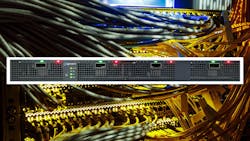400G/800G Ethernet Validation Platforms Seed Cloud-Infrastructure Evolution
The Overview
Spirent's latest 400G and 800G test platforms help accelerate the design and development of new-generation high-speed Ethernet technologies. With these platforms, service providers and hyperscale data centers can ensure their 400G infrastructure meets current data-growth needs while preparing for 800G as the future workhorse of the cloud’s backbone.
Who Needs It and Why?
100G (100 Gb/s) Ethernet has had a good run as the backbone technology behind the cloud, but the industry is moving on. It has no choice, really, given the exploding demand for bandwidth in the 5G/mmWave era that's now upon us. Many service providers and data centers, for various reasons, skipped over 400G Ethernet implementations and are looking toward 800G Ethernet for their next network transport overhaul. Adoption of 400G is still happening, but the growth of 800G will eclipse it before long.
Thus, service providers and hyperscale data-center operators must gear up now for the coming reinvention of the cloud's Ethernet backbone. They must ensure that their next-generation 800G infrastructure is bulletproof as they move from either 100G or 400G to an 800G network transport future. This applies equally to transceiver/cable vendors, chipset manufacturers, and network-equipment manufacturers.
Under the Hood
Spirent is rolling out a line of high-speed Ethernet test appliances to handle 400G and 800G requirements. At the highest end, the B2 800G appliance is a native QSFP-DD800 test platform intended to support development of highly flexible multi-rate products.
The 4-port unit supports 1x800G in addition to 2x400G, 4x200G, and 8x100G PAM4 modes, which meets with Ethernet Technology Consortium 800GBASE-R standards. As an end-to-end validation platform, the B2 800G appliance validates forwarding performance, latency, MAC capacity, and functional capabilities in an integrated approach that reduces cost of ownership.
The company had already released its B1 800G appliance, which comes in 2- and 4-port QSFP-DD versions and supports 8x50GbE, 4x200GbE, 2x400GbE, and 8x100GbE PAM4 modes for IEEE 802.3ck testing. The B2 adds the 1x800G support.
Meanwhile, 400G technology is more mature than the still consolidating 800G technology; testing for 400G has ramped up to test cases that are beyond 800G's ken at this point. Spirent's next generation of 400G appliances will reflect the need for higher port counts. These start with the A1 400G, which provides 16 400GbE ports per 2U appliance. It represents the industry’s highest port density to validate infrastructure and services dependent on high-speed Ethernet technologies, with traffic loads that emulate the real world.
Each of the A1 400G's 16 ports supports:
- PAM4: 1x400GbE, 2x200GbE, 4x100GbE, and 8x50GbE
- NRZ: 1x200GbE, 2x100GbE, 4x50GbE, 2x40GbE, 8x25GbE, and 8x10GbE (optional licenses may be required to support NRZ encoding)
All of these high-speed Ethernet test platforms run on Spirent's TestCenter application, which means that the UI look and feel is common across 400G and 800G uses.
About the Author
David Maliniak
Executive Editor, Microwaves & RF
I am Executive Editor of Microwaves & RF, an all-digital publication that broadly covers all aspects of wireless communications. More particularly, we're keeping a close eye on technologies in the consumer-oriented 5G, 6G, IoT, M2M, and V2X markets, in which much of the wireless market's growth will occur in this decade and beyond. I work with a great team of editors to provide engineers, developers, and technical managers with interesting and useful articles and videos on a regular basis. Check out our free newsletters to see the latest content.
You can send press releases for new products for possible coverage on the website. I am also interested in receiving contributed articles for publishing on our website. Use our contributor's packet, in which you'll find an article template and lots more useful information on how to properly prepare content for us, and send to me along with a signed release form.
About me:
In his long career in the B2B electronics-industry media, David Maliniak has held editorial roles as both generalist and specialist. As Components Editor and, later, as Editor in Chief of EE Product News, David gained breadth of experience in covering the industry at large. In serving as EDA/Test and Measurement Technology Editor at Electronic Design, he developed deep insight into those complex areas of technology. Most recently, David worked in technical marketing communications at Teledyne LeCroy, leaving to rejoin the EOEM B2B publishing world in January 2020. David earned a B.A. in journalism at New York University.

